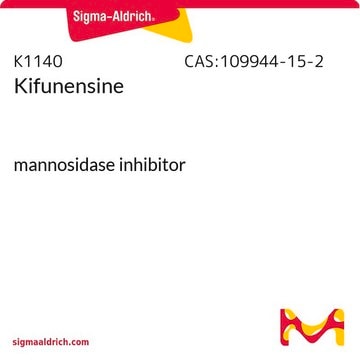SML1620
NGI-1
≥95% (HPLC)
Sinonimo/i:
5-[(Dimethylamino)sulfonyl]-N-(5-methyl-2-thiazolyl)-2-(1-pyrrolidinyl)-benzamide, ML414
Autenticatiper visualizzare i prezzi riservati alla tua organizzazione & contrattuali
About This Item
Formula empirica (notazione di Hill):
C17H22N4O3S2
Numero CAS:
Peso molecolare:
394.51
Codice UNSPSC:
12352200
NACRES:
NA.77
Prodotti consigliati
Livello qualitativo
Saggio
≥95% (HPLC)
Forma fisica
powder
Colore
white to beige
Solubilità
DMSO: 5 mg/mL, clear (warmed)
Temperatura di conservazione
2-8°C
Categorie correlate
Azioni biochim/fisiol
NGI-1 (ML414) is an inhibitor of Asparagine (N)-linked glycoslysation. NGI-1 inhibits the oligosaccharyltransferase, preventing the attachment to the protein. NGI-1 has been shown to induce senescence in receptor tyrosine kinase dependent tumors.
Codice della classe di stoccaggio
11 - Combustible Solids
Classe di pericolosità dell'acqua (WGK)
WGK 3
Certificati d'analisi (COA)
Cerca il Certificati d'analisi (COA) digitando il numero di lotto/batch corrispondente. I numeri di lotto o di batch sono stampati sull'etichetta dei prodotti dopo la parola ‘Lotto’ o ‘Batch’.
Possiedi già questo prodotto?
I documenti relativi ai prodotti acquistati recentemente sono disponibili nell’Archivio dei documenti.
Danielle Skropeta
Bioorganic & medicinal chemistry, 17(7), 2645-2653 (2009-03-17)
In a series of investigations, N-glycosylation has proven to be a key determinant of enzyme secretion, activity, binding affinity and substrate specificity, enabling a protein to fine-tune its activity. In the majority of cases elimination of all putative N-glycosylation sites
Angelyn Larkin et al.
Biochemistry, 50(21), 4411-4426 (2011-04-22)
Asparagine-linked glycosylation involves the sequential assembly of an oligosaccharide onto a polyisoprenyl donor, followed by the en bloc transfer of the glycan to particular asparagine residues within acceptor proteins. These N-linked glycans play a critical role in a wide variety
Cecilia Lopez-Sambrooks et al.
Nature chemical biology, 12(12), 1023-1030 (2016-10-25)
Asparagine (N)-linked glycosylation is a protein modification critical for glycoprotein folding, stability, and cellular localization. To identify small molecules that inhibit new targets in this biosynthetic pathway, we initiated a cell-based high-throughput screen and lead-compound-optimization campaign that delivered a cell-permeable
Ryan A Flynn et al.
Cell, 184(12), 3109-3124 (2021-05-19)
Glycans modify lipids and proteins to mediate inter- and intramolecular interactions across all domains of life. RNA is not thought to be a major target of glycosylation. Here, we challenge this view with evidence that mammals use RNA as a
Shih-Han Wang et al.
American journal of cancer research, 12(10), 4721-4736 (2022-11-17)
N-linked glycosylation of proteins is one of the post-translational modifications (PTMs) that shield tumor antigens from immune attack. Signaling lymphocytic activation molecule family 7 (SLAMF7) suppresses cancer cell phagocytosis and is an ideal target under clinical development. PTM of SLAMF7
Il team dei nostri ricercatori vanta grande esperienza in tutte le aree della ricerca quali Life Science, scienza dei materiali, sintesi chimica, cromatografia, discipline analitiche, ecc..
Contatta l'Assistenza Tecnica.







